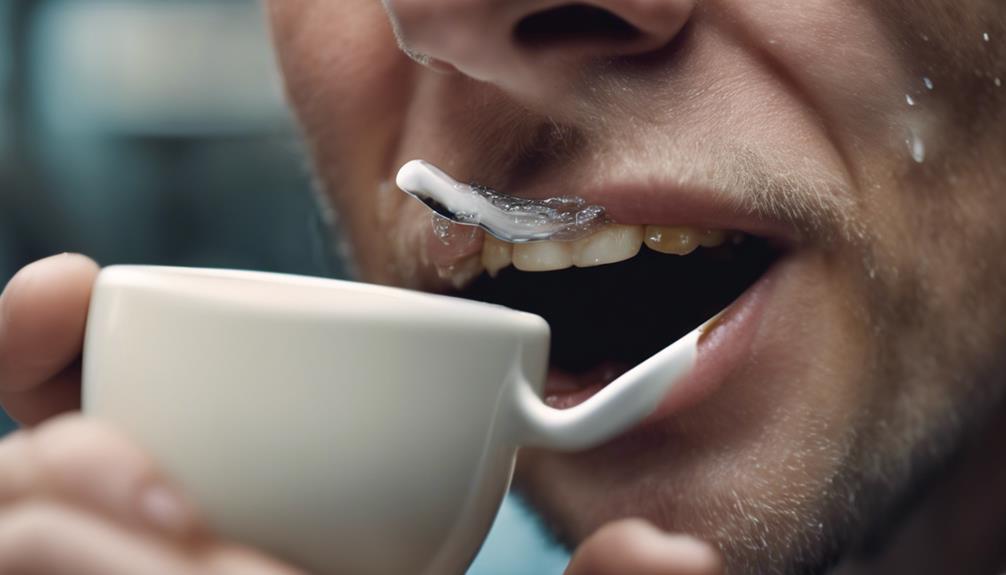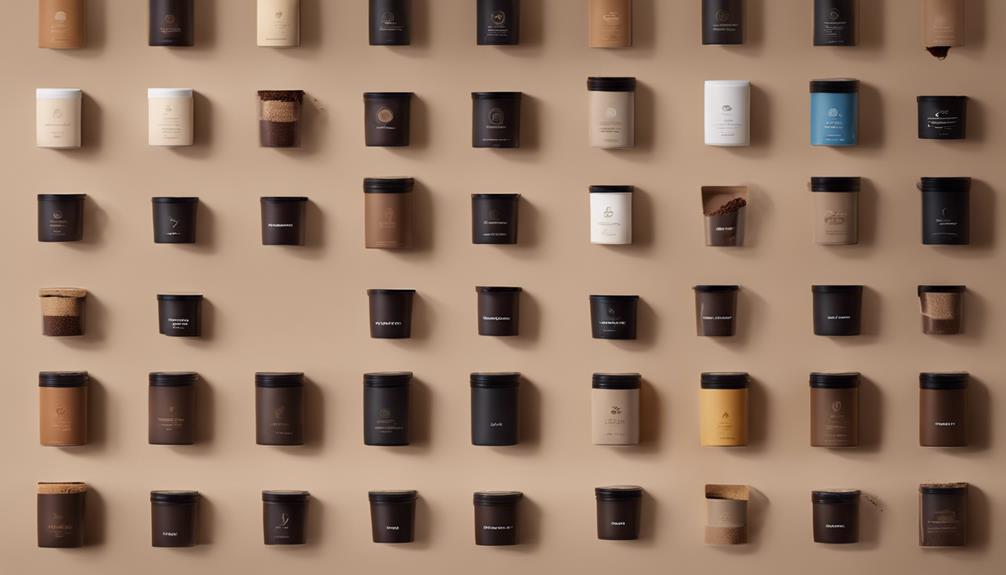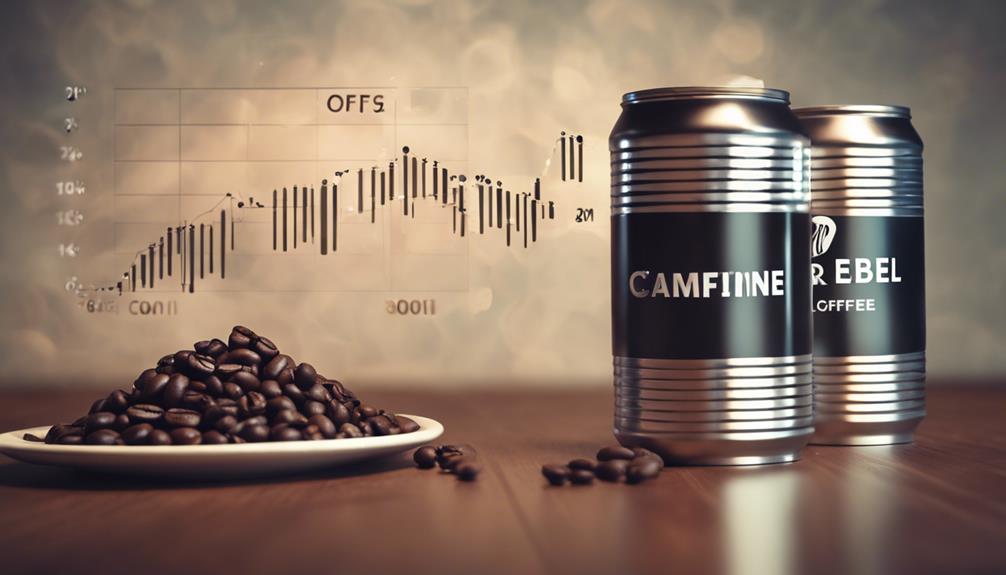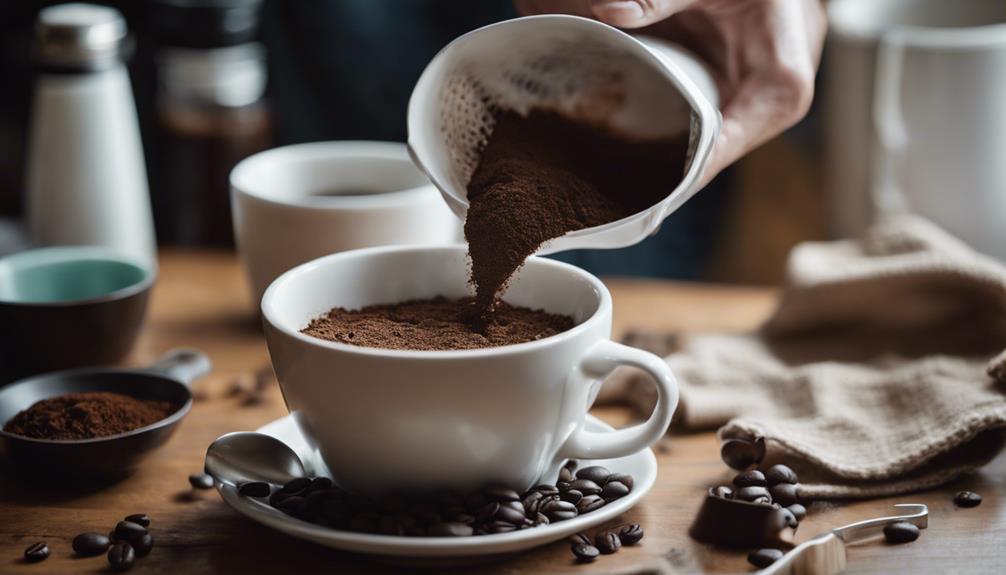To drink coffee safely with braces, it is recommended to use a straw to minimize contact with your teeth and reduce staining. After drinking coffee, rinse your mouth with water to help remove coffee particles. Consider opting for a lighter roast coffee or adding milk to lower acidity levels and protect your enamel from erosion. Make sure to clean your teeth regularly after consuming coffee to prevent plaque buildup. Using a Waterpik can be effective in cleaning around braces and dislodging trapped particles. You may also want to explore alternatives like herbal teas or decaf options to maintain your oral health. By following these tips, you can enjoy your coffee without jeopardizing your braces.
Key Takeaways
- Use a straw to prevent direct contact with teeth and braces.
- Rinse with water after to wash away coffee particles.
- Maintain good oral hygiene practices post-coffee consumption.
- Opt for lighter roasts or add milk to reduce acidity.
- Consider alternatives like herbal teas to protect braces from staining.
Risks of Drinking Coffee With Braces
When wearing braces, consuming coffee poses risks that can impact both the appearance and health of your orthodontic treatment. Coffee, known for its staining properties, can discolor the brackets and wires of your braces, affecting their aesthetic appeal.
The acidity in coffee can also weaken tooth enamel, potentially leading to damage over time. Additionally, drinking coffee with braces increases the risk of plaque buildup, decay, and gum disease due to poor oral hygiene practices that can result from trapped coffee particles.
These issues not only affect the progress of your orthodontic treatment but also your overall oral health. To mitigate these risks, it's essential to maintain good oral hygiene habits, attend regular dental check-ups, and consider ways to minimize the impact of coffee on your braces.
Tips for Stain Prevention

To prevent staining on your braces while drinking coffee, consider implementing these helpful tips for stain prevention:
- Use a straw: When enjoying your coffee, using a straw can help minimize direct contact between the coffee and your teeth, reducing the risk of staining on your braces.
- Rinse with water: After drinking coffee, rinse your mouth with water. This simple step can help wash away any coffee particles that may linger on your teeth and braces, potentially causing stains.
- Practice good oral hygiene: Brushing and flossing after consuming coffee can prevent plaque buildup, maintaining your oral health and reducing the chances of staining on your braces.
- Opt for lighter roasts or add milk: Choosing lighter coffee roasts or adding milk to your coffee can decrease its acidity, which helps lessen the chances of enamel erosion and staining on your braces.
Using a Waterpik for Cleaning

Incorporate a Waterpik into your oral care routine for effective cleaning around braces and maintaining good oral hygiene. Using a Waterpik can be highly beneficial when you have braces. The pulsating water stream can efficiently dislodge trapped particles and coffee stains around brackets and wires, reaching areas that traditional brushing may miss. This method not only aids in preventing plaque buildup but also enhances the cleanliness of your teeth.
Orthodontists often recommend Waterpiks for individuals with braces due to their effectiveness in cleaning around orthodontic appliances. By integrating a Waterpik into your daily oral hygiene routine, you can be certain that your teeth remain healthy and free from debris while wearing braces. Remember, consistent use of a Waterpik can complement your brushing and flossing efforts, contributing to better oral hygiene overall.
Drinking Coffee Through a Straw

Consider using a straw when enjoying your coffee to minimize direct contact with your teeth and reduce the risk of staining, especially if you have braces.
Here's why using a straw can be beneficial:
- Straw to Minimize Staining: By sipping your coffee through a straw, you can greatly reduce the chances of coffee making direct contact with your teeth, helping to keep them free from unsightly stains.
- Prevent Coffee from Touching Braces: Using a straw acts as a barrier, preventing coffee from coming into contact with your metal braces. This can help avoid discoloration and maintain the appearance of your braces.
- Guiding Coffee Past Front Teeth: Straws provide a pathway for coffee to bypass the front teeth, lowering the likelihood of visible stains on the enamel, especially important when you have braces that can easily trap liquids.
- Maintain a Brighter Smile: Opting for a straw while drinking coffee with braces can help preserve a brighter smile by preventing coffee-related discoloration, ensuring your teeth stay looking their best.
Alternatives to Coffee

When looking for alternatives to coffee while wearing braces, consider trying herbal teas, decaf options, or herbal infusions. These beverages provide a caffeine-free choice that's less likely to stain your teeth, making them a safer option for your oral health.
Exploring these substitutes can offer a variety of flavors and benefits without compromising your braces or risking tooth discoloration.
Coffee Substitutes
Explore various coffee substitutes that are gentle on your teeth and braces, providing flavorful alternatives to your morning brew.
- Herbal Teas: Opt for caffeine-free herbal teas as a substitute for coffee. Not only are they less likely to stain your teeth and braces, but they also offer a variety of flavors to suit your taste preferences.
- Milk-Based Drinks: Consider indulging in milk-based drinks like lattes instead of black coffee. These options are gentler on your teeth and braces, making them a safer choice for your oral health.
- Fruit Smoothies: Embrace braces-friendly fruit smoothies as a delightful alternative to coffee. They aren't only tasty but also provide a hydrating and nutritious option to kickstart your day.
- Hydrating with Water: Keep your teeth and braces healthy by hydrating with plain or infused water. Water can help rinse away any acidity left by coffee, protecting your tooth enamel and overall oral health.
Decaf Options
Looking for a coffee alternative that's gentler on your braces? Decaf coffee is a fantastic option worth exploring. Decaf options can help minimize the risks associated with regular coffee consumption, such as staining and enamel erosion, which can be particularly concerning for those with braces.
By choosing decaffeinated coffee, you can still savor a similar flavor experience without compromising your oral health or the condition of your braces.
Decaf coffee stands out as a gentle choice for individuals undergoing orthodontic treatment. It allows you to enjoy a warm beverage without the negative impact that caffeinated coffee might've on your braces.
Opting for decaf can be a smart move to maintain the health of your teeth and gums while still indulging in a comforting drink. So, next time you're craving a cup of coffee but want to be mindful of your braces, consider reaching for a soothing decaf alternative.
Herbal Infusions
Consider incorporating herbal infusions like chamomile, peppermint, or rooibos tea as caffeine-free alternatives to coffee for a braces-friendly beverage option. These herbal teas are less likely to stain teeth or braces compared to coffee.
Here are four reasons to choose herbal infusions over coffee:
- Stain Prevention: Herbal infusions are less likely to discolor your teeth or braces, helping you maintain a bright smile during orthodontic treatment.
- Gentle on Teeth: Unlike coffee, herbal infusions are gentle on your teeth, making them a suitable choice for those with sensitive teeth or braces.
- Health Benefits: Herbal teas offer various health benefits, such as calming effects from chamomile or digestion aid from peppermint, enhancing your well-being.
- Flavorful and Soothing: Enjoy the soothing and flavorful experience of herbal infusions without the risks associated with coffee consumption, providing a pleasant alternative for your daily beverage routine.
Incorporate herbal infusions into your daily habits to protect your braces and oral health.
Maintaining Dental Hygiene With Braces

To maintain dental hygiene with braces, make sure you brush and floss your teeth after drinking coffee to prevent staining and plaque buildup around the brackets and wires. Brushing and flossing regularly is essential to remove any coffee residue that can accumulate on your braces and teeth.
Additionally, consider rinsing your mouth with water after consuming coffee to help wash away any remaining particles that may get trapped in the braces, reducing the risk of staining and decay. Using a straw when drinking coffee can also minimize direct contact with your teeth, further decreasing the chances of discoloration.
Incorporating a Waterpik into your dental hygiene routine can be beneficial for effectively cleaning around the brackets and wires. This tool can help dislodge any food particles that are hard to reach with traditional brushing and flossing methods.
Frequently Asked Questions
How to Drink Coffee With Braces?
When wearing braces, drinking coffee can pose risks to your oral health. To protect your teeth and braces, it's advisable to use a straw to minimize direct contact, rinse your mouth with water afterward, and limit coffee intake to prevent staining and enamel erosion.
Brushing after consumption and opting for lighter roasts or adding milk can help reduce acidity. Prioritize good oral hygiene practices and be mindful of your coffee habits for best dental health with braces.
Do I Need to Brush My Teeth After Coffee With Braces?
Yes, you should brush your teeth after consuming coffee with braces. Brushing helps remove coffee residue that can stain and weaken enamel, maintaining oral health and preventing discoloration.
Good oral hygiene practices, such as post-coffee brushing, are essential for protecting your teeth and braces. Regularly cleaning your teeth after coffee consumption with braces minimizes the impact of staining and acidity on enamel, ensuring the integrity of your orthodontic appliances.
Will Coffee Stain Clear Braces?
Yes, coffee can stain clear braces due to their susceptibility to discoloration from tannins and chromogens in coffee.
Regular maintenance and cleaning are essential to prevent coffee stains on clear braces.
To minimize direct contact, consider using a straw when drinking coffee.
For personalized advice on managing and preventing coffee stains on clear braces, it's best to consult with your orthodontist.
Prioritize care to keep your clear braces looking their best.
Is Coffee Not Allowed for Braces?
Being cautious when consuming coffee with braces is crucial to avoid risks like staining, enamel erosion, and hygiene challenges.
Staining can affect brackets and wires, requiring careful oral hygiene practices. The acidity of coffee can gradually weaken tooth enamel.
To minimize these risks, limit coffee intake, rinse with water after consumption, and maintain good oral hygiene.
Exploring alternatives such as herbal teas, milk-based drinks, or water can help reduce the impact on braces.
Can I Use the Same Tips for Drinking Hot Coffee with Braces as I Can with Invisalign?
Yes, you can use the same tips for drinking hot coffee with invisalign as you can with braces. Be mindful of the temperature of the coffee to prevent warping or discoloration of the Invisalign aligners. It’s also important to brush and clean your teeth after consuming coffee to avoid staining.
Conclusion
To sum up, enjoying your favorite cup of coffee while wearing braces can be done safely with the right precautions. By following the tips for stain prevention, using a Waterpik for cleaning, drinking through a straw, and exploring alternatives to coffee, you can still indulge in your caffeine fix without causing harm to your braces.
Remember to maintain good dental hygiene practices to keep your smile healthy and bright throughout your orthodontic treatment.









